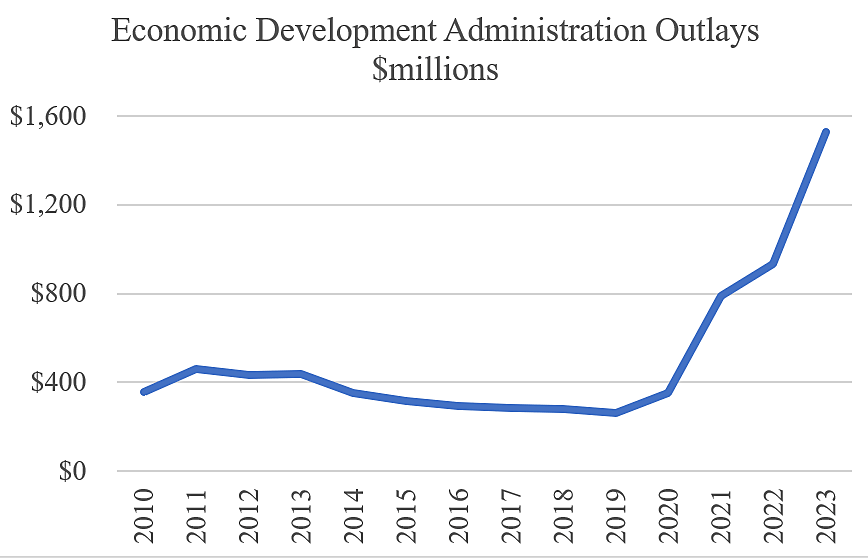Discretionary spending was restricted for 2024 and 2025 as part of the most recent debt ceiling agreement. However, House conservatives are pushing for deeper cuts and more reforms in appropriations legislation for the coming fiscal year (2024). According to Kay Granger, the chair of the House Appropriations Committee, 'the debt ceiling bill set a ceiling, not a floor' for spending in 2024.
Consider the Economic Development Administration (EDA), which provides private industry, state and local governments, and other entities with annual subsidies totaling hundreds of millions of dollars. The data depicts the dramatic increase in EDA spending from $264 million in 2019 to $1.53 billion in 2023. Recent legislation, such as the American Rescue Plan and CHIPS acts, helped the EDA budget.

According to the EDA, which was established in 1965, its function is to "lead the federal economic development agenda." The organization distributes funding liberally to congressional districts all throughout the country for a wide range of initiatives. Members of Congress who are eager to obtain funding for their districts fail to appropriately challenge the grandiose claims made by EDA executives regarding employment and investment.
Federal auditors have questioned some of the EDA's statements, and Cato has criticized the agency. According to testimony from the Government Accountability Office, the EDA's reliance on grantee estimates "may lead to inaccurate claims about program results." The "gulf between promise and performance" at the EDA has long been noticed by analysts.
What types of projects does the EDA finance? The initiatives listed below, which fall into two categories, were highlighted in EDA annual reports from 2018 through 2021 (see here). There are two types of initiatives that, if useful, should have been funded: 1) by the states, and 2) by the private sector.
Should have been funded by the states:
- $8,350,057 to improve the International Parkway Bridge in Tracy, California (2021).
- $7,899,000 to make levee upgrades in Hamburg, Iowa (2020).
- $5 million to renovate the University of Texas Coastal Ocean Science building (2019).
- $1,975,800 to Delaware Technical and Community College for a skills training facility (2018).
- $3,806,761 for a new generator at the University of South Alabama (2021).
Should have been funded by the private sector:
- $2,546,760 to the Institute for Advanced Learning and Research to purchase equipment for training employees (2021).
- $10,214,022 for Leon County Research and Development Authority to build a business incubator in Tallahassee (2020).
- $7,872,090 to Blue Lake Rancheria, California, to build a local business incubator (2019).
- $2,030,000 to help Cedars‐Sinai Biomanufacturing Center purchase equipment (2018).
- $1,996,160 to purchase equipment for training at the Fairbanks Pipeline Training Center Trust (2021).
The EDA does not have special skills for boosting economic growth that the states and private sector do not have. Federal funding of local industrial parks, incubators, equipment, and other items just adds bureaucracy. Taxpayers pay for the federal EDA bureaucracy of more than 300 employees, and then those folks impose rules and regulations on local partners, which further raises costs. To receive EDA funding, for example, regions must complete central‐planning‐style “Comprehensive Economic Development Strategies.”
The EDA frequently asserts that its projects provide great returns, but if this were true, the states and private sector would be happy to fund such initiatives and we would not require the agency. The EDA claims that it is meeting needs in other instances. According to the EDA director who testified in court, "many projects would struggle to attract the necessary capital without the support and funding of EDA." However, it's possible that those initiatives fail as a result of poor management or economic failure.EDA initiatives can also create a zero-sum competition between jurisdictions, which is another issue. According to David Bier's analysis of the EDA, the organization donated $2 million to Visalia, California, to build an industrial park, but that subsidy later forced a medical equipment business to move hundreds of jobs from other parts of the state. In these situations, EDA subsidies produce winners and losers but most likely have little net value.
The EDA is one of many programs that disperse federal funding for local development around the nation. Local communities that require development can, however, change their own taxes and rules to encourage innovation and private investment. Governments that foster favorable business and labor environments can succeed without financial assistance.
Numerous factors make government support of local projects ineffective, and given continuous federal deficits of more than $1.5 trillion annually, it is not feasible. The Reagan and Trump administrations both advocated for abolishing the EDA. Republicans in the House should try reform once more.


























